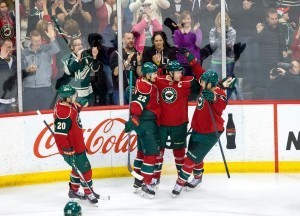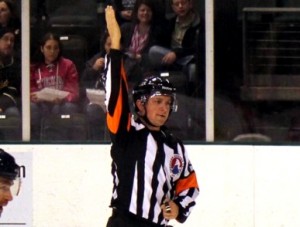As the 2014-15 regular season comes to a close, one of the biggest takeaways that anyone can get out of what’s transpired this year is the lack of scoring that took place. Whether you believe that it’s due to better goaltending, leniency when it comes to penalty calls or something else, there’s no denying that scoring in the NHL just isn’t what it used to be.

For the first time since Martin St. Louis scored 94 points for the Tampa Bay Lighting in 2003-04, the NHL will have an Art Ross Trophy winner finish with less than 100 points during a full season. It’ll be just the fourth time since 1970 that the league’s leading scorer failed to hit the 100 point mark. What’s even more remarkable, however, is the fact that it will likely be the first time that the Art Ross Trophy goes to someone who failed to reach 90 points — John Tavares of the New York Islanders and Sidney Crosby of the Pittsburgh Penguins each have 83 points entering play on April 8 — during a non-lockout shortened season.
When the NHL approved new rules prior to the start of the 2014 season, it was believed that scoring would improve based on the changes. These changes included an increase in size for the goaltending trapezoid, tripping penalties called whether or not a player touches the puck first and a change in the spacing between players during faceoffs, among others. All of these were done with the idea of increasing potential power play times as well as scoring opportunities in general.
Though most teams still have two games remaining on the schedule as of posting, penalties as a whole are down from last season. The 2013 season saw a total of 9076 minor penalties taken whereas this season has seen just 8309 penalties through a combined 2398 games. That equates to about 3.5 minor penalties taken per game compared to that of 3.7 per game last season. It’s not much of a difference, but the fact that penalties are down during a season in which a new rule was implemented to increase the number of calls can be pointed to as a reason for the lack of scoring.

But it’s not just fewer penalty calls that have resulted in the players not producing at as high of a level as many believe they can on offense. A number of factors are involved, including star players not needing to be on the ice as often due to everyone else in the league being of a much better caliber of player than in the past. Still, things can be done to improve goal totals in the NHL, and I’ve got a few ideas of my own.
Now, the idea of changing the sizes of the nets and goalie equipment in order to increase goals has been beaten to death, so I’m just going to avoid those specific arguments all together. Instead, I’m going to focus on general rule changes that could be made in order to finally get scoring in the league to where fans really want it to be. And no, that doesn’t mean wanting every game to be a 6-5 affair.
Rule #1: No icing the puck during a penalty kill
This rule has been brought up by others, and it makes the most sense. Why allow the team that committed the infraction to be able to just dump the puck down the ice whenever they get control while shorthanded? Isn’t the point of a penalty to punish the team who commits it? By forcing penalized teams to get the puck past center ice before dumping it into the zone, the chances of more man advantage scoring opportunities are bound to increase simply because the risk of turnover is greater than if they just dump the puck and go on a change.
Rule #2: Eliminate Clutching
From Crosby to Alex Ovechkin to Tyler Seguin, the NHL has no shortage of star players. But why aren’t they lighting up the score sheet like they have in the past? I

personally feel it’s due to the NHL allowing players more leeway when it comes to clutching and pulling the offensive team. Defensive players have gained a bit of an advantage over the past few seasons with the increased ability to hook and grab offensive players without being called for a penalty. When more of these types of penalties were being called, specifically during the 2005-06 season when teams averaged nearly six power plays per game, scoring was through the roof. In fact, at 7591 goals for that season, the overall goal total is over 1000 more than what the NHL is at this season (6566).
By taking away a defenders ability to use his arms to slow down an offensive player, you put the focus on them either hitting them off the puck or using their sticks to break up a play. This method would no doubt increase five-on-five scoring opportunities as well as the possibility for more power play chances.
Rule #3: Minor penalties last full duration/More goals allowed per power play
Up until 1956 in the NHL, if a player took a penalty that player was in the box for the duration of the call. It may be time that the league goes back to that model, or at least a form of it. More time penalty time equals more scoring opportunities. I know this proposal is likely to be the most debated one of the three I’ve listed, but I think there is a way to compromise with those who’d rather see it remain where one goal is allowed per minor penalty.
If you don’t want them to be treated like a major penalty where the team on the power play can score as many goals until the time runs out, then change it up to allow more than one goal to be scored before a team returns to full strength. Something like implementing a rule in which a team on the power play remains on the man advantage until either time expires or two goals are scored could really help increase the amount of scoring while not fully damning the team on the penalty kill.
It can also have an effect on five-on-five opportunities as well. With teams knowing that a minor penalty wouldn’t end after just one goal, the amount of chances a defending player takes could come down, leading to more full strength scoring chances.
Those are my ideas, but what do others have to say about the matter? I posed the question on Twitter, and these are some of the responses:
@MikeStrawWrites Prevent players from being able to go to the ice to block shots would be #1
— WNY HOCKEY PROSPECTS (@wnyh2234) April 8, 2015
@MikeStrawWrites The amount of players laying on the ice in front of the net cheapens the game. Especially on PP the congestion’s awful — WNY HOCKEY PROSPECTS (@wnyh2234) April 8, 2015
@MikeStrawWrites olympic ice
— Mitch Courtney (@Mitch_Courtney1) April 8, 2015
@MikeStrawWrites allow for some kicking motion w/blade on ice. Allow for the “punching” of pucks into the net, below the x-bar.
— Justin Banker (@JustinTBanker) April 8, 2015
@MikeStrawWrites 3/4 of my league games are on an Olympic pad, it’s a very different game compared to #NHL sized rinks. Gotta open it up.
— Cult of Personality (@CoffeeCult448) April 8, 2015